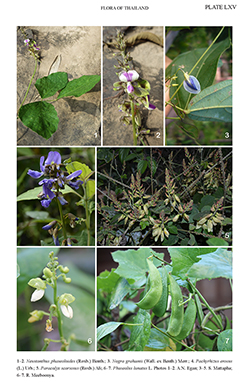e-Flora of Thailand
Volume 4 > Part 3.3 > Year 2023 > Page 637 > Leguminosae-Papilionoideae > Pachyrhizus
Pachyrhizus erosus (L.) Urb.wfo-0000183119
Symb. Antill. 4(2): 311. 1905; Merr., Fl. Manila: 263. 1912; Craib, Fl. Siam. 1(3): 459. 1928; Backer & Bakh.f., Fl. Java 1: 643. 1963; T.C.Huang & H.Ohashi in H.L.Li et al., Fl. Taiwan 3: 348, pl. 624. 1977 & ed. 2, 3: 350, pl. 182. 1993; Verdc., Man. New Guinea Leg.: 477, f. 112. 1979; Grierson & D.G.Long, Fl. Bhutan 1(3): 691. 1987; M.Sørensen, Nord. J. Bot. 8(2): 177. 1988; Rudd in Dassanayake & Fosberg, Revis. Fl. Ceylon 7: 283. 1991; T.L.Wu & Thulin in C.Y.Wu et al., Fl. China 10: 241. 2010.— Dolichos erosus L., Sp. Pl. 2: 726. 1753. Plate LXV: 4.
Accepted Name : This is currently accepted.
Synonyms & Citations :
Description : Herb climbing or trailing; root tubers smoothly-rounded, turnip-shaped to elongated or lobed, up to 30 cm in diameter, 25 cm long, with light and dark brown surface and white flesh; stem spirally striated or angular, strigose to hirsute. Stipules linear to lanceolate, sericeous, 5–10 mm long. Leaves: petioles 3–12 cm long, both surfaces strigose or hirsute, often upper surface less strigose than lower surface; stipels 3–8 mm long, linear, lanceolate or subulate, sericeous. Leaflets: petiolules 4–7 mm long, densely hirsute, drying angular; terminal leaflet ovate to rhomboid, broadly rhomboid, broadly elliptic or fan-shaped, obscurely or coarsely dentate or slightly to deeply palmately lobed with 3–5(–7) lobes, rarely entire, apex acute or rounded, mucronate, base cuneate, 5-veined, 3–18 by 5–20 cm; lateral leaflets obliquely rhomboid or ovate, 4–18 by 4–20 cm, with 3 basal veins, lower surface sparsely pubescent, upper margin entire somewhat dentate or slightly deeply palmately lobed. Inflorescences 5–65 cm long, strigose to hirsute near apex; peduncle strigose, 8–40 cm long; floral prophyll 1–3 mm long. Flowers 3–5, in dense cluster on short pedicels at each node of inflorescence axis; pedicels 4–10 mm long. Calyx campanulate, 7.5–13.5 mm long, appressed brown pubescent both sides; tube 4–6.5 mm long; upper lobe 2.5–7.5 mm long; lower three lobes lanceolate, acute and shorter than the tube. Corolla purplish white or pinkish white; standard broadly elliptic or suborbicular, 15–22 by 9–17 mm, with yellowish green spot and 2 thickenings near base; wings elliptic or falcate, 11–24 mm long, connate at base, claw 2–6 mm long, auriculate 1.5–4.5 mm long, glabrous; keel narrowly ovate or sub-falcate, 15–24 mm long, claw 5–10 mm long, glabrous. Stamens 8–22 mm long. Ovary yellowish hirsute; style incurved, 15–25 mm long. Pods 6–14 by 1–1.8 cm, strigose to hirsute when young, glabrescent, green or yellowish, pubescent. Seeds 4–10, square or slightly rounded, 5–8 by 5–9 mm, brown or reddish brown, appressed pubescent.
Thailand : NORTHERN: Chiang Mai (Chiang Dao, Doi Suthep-Pui NP, Fang, Hang Dong, Mae Rim, San Sai), Nan, Lamphun (Doi Khun Tan NP), Phrae (Mae Yom NP), Tak (Umphang); NORTH-EASTERN: Loei (Phu Kradueng); EASTERN: Nakhon Ratchasima (Bua Yai, Pak Thong Chai); SOUTH-WESTERN: Kanchanaburi (Sangkhla Buri, Thong Phaphum); CENTRAL: Lop Buri, Saraburi (Kaeng Khoi), Krung Thep Maha Nakhon (Bangkok); SOUTH-EASTERN: Chachoengsao.
Distribution : Native to Central America (type); widely cultivated in tropical regions.
Ecology : Cultivated as a vegetable and an occasional escape in grassland, scrub, deciduous or hill evergreen forest; 0–980 m alt. Flowering and fruiting: August–November.
Vernacular : Khruea khao khon on (เครือเขาขน), mak bang (หมากบ้ง)(Phetchaburi); thua kin hua (ถั่วกินหัว), thua bong (ถั่วบ้ง), man kaeo la waek (มันแกวละแวก), man kaeo lao (มันแกวลาว), man la waek (มันละแวก), man lao (มันลาว)(Northern); man kaeo (มันแกว)(Central); pae kua (แปะกัวะ)(Peninsular).
CommonName : Yam bean.
Uses: Cultivated for its edible tubers and young pods which may be eaten; in the mature state they can be poisonous.

